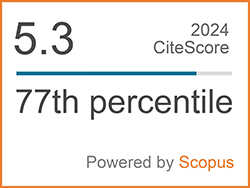Genetic Diversity of Hemp Germplasm in Northern Thailand
Abstract
Cannabis sativa L., commonly known as hemp, is a plant native to Central Asia. It is well known for its cannabinoid compounds, which have significant potential for medical applications. Recognizing the economic and medical value of hemp, the Thai government has permitted its cultivation for commercial, medical, and research purposes. However, a comprehensive understanding of hemp genetics is crucial to support industry expansion and enhance future breeding programs. This study investigated the genetic diversity of 37 hemp accessions collected in northern Thailand, along with two reference varieties (RPF1 and RPF2). Using DArTSeq-based genotyping-by-sequencing and whole-genome sequencing technologies, we identified 3,609 single nucleotide polymorphisms (SNPs). STRUCTURE analysis, principal component analysis (PCA), and neighbor-joining analysis consistently identified three genetic clusters; however, these clusters did not correlate with geographical locations. Genetic differentiation among clusters was observed (fixation index, FST = 0.064-0.079; Nei’s coefficient of genetic differentiation, Nei’s GST = 0.058-0.078). Total genetic diversity estimated (expected heterozygosity, HE = 0.348; observed heterozygosity, HO = 0.092). Global inbreeding (FIT = 0.033) and molecular variance (4.83%) suggested low to moderate genetic differentiation, while the high inbreeding coefficient (FIS = 0.737) indicated substantial inbreeding within clusters. The genetic data from this study provide a resource for developing molecular markers to distinguish hemp varieties, supporting selective breeding efforts. These findings will contribute to improving agronomic traits, conserving genetic diversity, and ensuring the sustainable use of hemp genetic resources.
Keywords
[1] A. Pollio, “The name of Cannabis: A short guide for nonbotanists,” Cannabis and Cannabinoid Research, vol. 1, no. 1, pp. 234–238, 2016.
[2] A. C. Zeven and J. M. De Wet, Dictionary of Cultivated Plants and Their Regions of Diversity: Excluding Most Ornamentals, Forest Trees and Lower Plants. Wageningen, Netherlands: Pudoc, 1982.
[3] R. G. Pertwee, Handbook of Cannabis. Oxford: Oxford University Press, 2014.
[4] G. Grassi and J. M. McPartland, “Chemical and morphological phenotypes in breeding of Cannabis sativa L.,” in Cannabis sativa L. Botany and Biotechnology, pp. 137–160, 2017.
[5] J. A. Toth, G. M. Stack, A. R. Cala, C. H. Carlson, R. L. Wilk, J. L. Crawford, D. R. Viands, G. Philippe, C. D. Smart, and J. K. C. Rose, “Development and validation of genetic markers for sex and cannabinoid chemotype in Cannabis sativa L.,” GCB Bioenergy, vol. 12, no. 3, pp. 213–222, 2020.
[6] J. Teitelbaum, “A hemp oil, CBD, and marijuana primer: powerful pain, insomnia, and anxiety-relieving tools,” Alternative Therapies in Health and Medicine, vol. 25, pp. 21–23, 2019.
[7] D. R. Blake, P. Robson, M. Ho, R. W. Jubb, and C. S. McCabe, “Preliminary assessment of the efficacy, tolerability and safety of a cannabis-based medicine (Sativex) in the treatment of pain caused by rheumatoid arthritis,” Rheumatology (Oxford, England), vol. 45, no. 1, pp. 50–52, 2006, doi: 10.1093/rheumatology/kei183.
[8] C. Cao, Y. Li, H. Liu, G. Bai, J. Mayl, X. Lin, K. Sutherland, N. Nabar, and J. Cai, “The potential therapeutic effects of THC on Alzheimer's disease,” Journal of Alzheimer's Disease, vol. 42, no. 3, pp. 973–984, 2014.
[9] A. Passani, C. Posarelli, A. T. Sframeli, L. Perciballi, M. Pellegrini, G. Guidi, and M. Figus, “Cannabinoids in glaucoma patients: The never-ending story,” Journal of Clinical Medicine, vol. 9, no. 12, p. 3978, 2020.
[10] S. Assanangkornchai, K. Thaikla, M. Talek, and D. Saingam, “Medical cannabis use in Thailand after its legalization: A respondent-driven sample survey,” PeerJ, vol. 10, p. e12809, 2022, doi: 10.7717/peerj.12809.
[11] M. Laohavanich, “Political economy of cannabis in Thailand,” Chulalongkorn Medical Journal, vol. 66, no. 1, Jul. 2023, doi: 10.58837/CHULA.CMJ.66.1.11.
[12] M. A. Nadeem, M. A. Nawaz, M. Q. Shahid, Y. Doğan, G. Comertpay, M. Yıldız, and F. S. Baloch, “DNA molecular markers in plant breeding: Current status and recent advancements in genomic selection and genome editing,” Biotechnology & Biotechnological Equipment, vol. 32, no. 2, pp. 261–285, 2017, doi: 10.1080/13102818.2017.1400401.
[13] D. Vlk and J. Řepková, “Application of next-generation sequencing in plant breeding,” Czech Journal of Genetics & Plant Breeding, vol. 53, no. 3, pp. 89–96, 2017.
[14] M. Agarwal, N. Shrivastava, and H. Padh, “Advances in molecular marker techniques and their applications in plant sciences,” Plant Cell Reports, vol. 27, pp. 617–631, 2008.
[15] A. Karp, O. Seberg, and M. Buiatti, “Molecular techniques in the assessment of botanical diversity,” Annals of Botany, vol. 78, no. 2, pp. 143–149, 1996.
[16] L. Mondini, A. Noorani, and M. A. Pagnotta, “Assessing plant genetic diversity by molecular tools,” Diversity, vol. 1, no. 1, pp. 19–35, 2009.
[17] K. Semagn, Å. Bjørnstad, and M. N. Ndjiondjop, “An overview of molecular marker methods for plants,” African Journal of Biotechnology, vol. 5, no. 25, pp. 2540–2568, 2006.
[18] D. Jaccoud, K. Peng, D. Feinstein, and A. Kilian, “Diversity arrays: A solid state technology for sequence information independent genotyping,” Nucleic Acids Research, vol. 29, no. 4, p. E25, 2001, doi: 10.1093/nar/29.4.e25.
[19] T. Gülck and B. L. Møller, “Phytocannabinoids: Origins and biosynthesis,” Trends in Plant Science, vol. 25, no. 10, pp. 985–1004, 2020. doi: 10.1016/j.tplants.2020.06.010.
[20] J. Sawler, J. M. Stout, K. M. Gardner, D. Hudson, J. Vidmar, L. Butler, J. E. Page, and S. Myles, “The genetic structure of marijuana and hemp,” PLOS ONE, vol. 10, no. 8, Aug. 2015, Art. no. e0133292, doi: 10.1371/journal.pone.0133292.
[21] C. Gao, P. Xin, C. Cheng, Q. Tang, P. Chen, C. Wang, G. Zang, and L. Zhao, “Diversity analysis in Cannabis sativa based on large-scale development of expressed sequence tag-derived simple sequence repeat markers,” PLOS ONE, vol. 9, no. 10, 2014, Art. no. e110638, doi: 10.1371/journal.pone.0110638.
[22] D. Vergara, C. Feathers, E. L. Huscher, B. Holmes, J. A. Haas, and N. C. Kane, “Widely assumed phenotypic associations in Cannabis sativa lack a shared genetic basis,” PeerJ, vol. 9, 2021, Art. no. e10672, doi: 10.7717/peerj.10672.
[23] D. A. Hoisington and R. K. Varshney, “Diversity Arrays Technology (DArT) low cost, generic molecular markers for breeding and research,” Biotech News, vol. 2, no. 1, pp. 6–8, 2007.
[24] T. Chaisan, P. Thobunluepop, N. Thongthip, A. Rakpenthai, B. Puangsin, S. Samipak, and W. Pluempanupat, “Identification of morphological traits affecting high seed yield potential from new hemp germplasm collected in Thailand,” Chilean Journal of Agricultural Research, vol. 85, no. 1, pp. 88–97, 2025. doi: 10.4067/S0718-58392025000100088.
[25] T. Saleepochn, S. Tharamak, S. Charanja, L. Pimsawang, T. Wisarutwanit, T. Chaisan, W. Songoen, and W. Pluempanupat, “Comparative fatty acid profiling of seed lines of hemp (Cannabis sativa L.) and inhibition of tyrosinase, α-glucosidase and acetylcholinesterase,” Agriculture and Natural Resources, vol. 58, no. 5, pp. 547–554, 2024. doi: 10.34044/j.anres.2024.58.5.01.
[26] R. Rattanapakdee, P. Thobunluepop, S. Anusonpornperm, T. Chaisan, A. Pongtip, P. Maniin, W. Chitbanchong, and S. Gorinstein, “Effects of harvest time on medicinal qualities of hemp,” Journal of Current Science and Technology, vol. 14, no. 3, Art. no. 63, 2024. doi: 10.59796/jcst.V14N3.2024.63.
[27] P. Chaowana, W. Hnoocham, S. Chaiprapat, P. Yimlamai, K. Chitbanyong, K. Wanitpinyo, T. Chaisan, Y. Paopun, S. Pisutpiched, S. Khantayanuwong, and B. Puangsin, “Utilization of hemp stalk as a potential resource for bioenergy,” Materials Science for Energy Technologies, vol. 7, pp. 19–28, 2024. doi: 10.1016/j.mset.2023.07.001.
[28] F. S. Baloch, A. Alsaleh, M. Q. Shahid, V. Çiftçi, L. E. Sáenz de Miera, M. Aasim, M. A. Nadeem, H. Aktaş, H. Özkan, and R. Hatipoğlu, “A whole genome DArTseq and SNP analysis for genetic diversity assessment in durum wheat from Central Fertile Crescent,” PLOS ONE, vol. 12, no. 1, 2017, Art. no. e0167821, doi: 10.1371/ journal.pone.0167821.
[29] S. Andrews. “FastQC: A quality control tool for high throughput sequence data.” bioinformatics. babraham.ac.uk. https://www.bioinformatics. babraham.ac.uk/projects/fastqc/ (accessed Mar. 17, 2025).
[30] A. M. Bolger, M. Lohse, and B. Usadel, “Trimmomatic: A flexible trimmer for Illumina sequence data,” Bioinformatics (Oxford, England), vol. 30, no. 15, pp. 2114–2120, 2014.
[31] H. Li and R. Durbin, “Fast and accurate short read alignment with Burrows-Wheeler transform,” Bioinformatics (Oxford, England), vol. 25, no. 14, pp. 1754–1760, 2009.
[32] H. Li, B. Handsaker, A. Wysoker, T. Fennell, J. Ruan, N. Homer, G. Marth, G. Abecasis, and R. Durbin, “The Sequence Alignment/Map format and SAMtools,” Bioinformatics (Oxford, England), vol. 25, no. 16, pp. 2078–2079, 2009.
[33] A. McKenna, M. Hanna, E. Banks, A. Sivachenko, K. Cibulskis, A. Kernytsky, K. Garimella, D. Altshuler, S. Gabriel, M. Daly, and M. A. DePristo, “The genome analysis toolkit: A MapReduce framework for analyzing next-generation DNA sequencing data,” Genome Research, vol. 20, no. 9, pp. 1297–1303, 2010.
[34] P. Danecek, J. K. Bonfield, J. Liddle, J. Marshall, V. Ohan, M. O. Pollard, A. Whitwham, T. Keane, S. A. McCarthy, R. M. Davies, and H. Li, “Twelve years of SAMtools and BCFtools,” GigaScience, vol. 10, no. 2, Feb. 2021, Art. no. giab008, doi: 10.1093/gigascience/giab008.
[35] P. Cingolani, A. Platts, L. Wang, M. Coon, T. Nguyen, L. Wang, S. J. Land, X. Lu, and D. M. Ruden, “A program for annotating and predicting the effects of single nucleotide polymorphisms, SnpEff: SNPs in the genome of Drosophila melanogaster strain w1118; iso-2; iso-3,” Fly, vol. 6, no. 2, pp. 80–92, 2012.
[36] W. J. Bruno, N. D. Socci, and A. L. Halpern, “Weighted neighbor joining: A likelihood-based approach to distance-based phylogeny reconstruction,” Molecular Biology and Evolution, vol. 17, no. 1, pp. 189–197, 2000, doi: 10.1093/oxfordjournals.molbev.a026231.
[37] K. Tamura, G. Stecher, and S. Kumar, “MEGA11: Molecular evolutionary genetics analysis version 11,” Molecular Biology and Evolution, vol. 38, no. 7, pp. 3022–3027, 2021, doi: 10.1093/molbev/msab120.
[38] L. Porras-Hurtado, Y. Ruiz, C. Santos, C. Phillips, A. Carracedo, and M. V. Lareu, “An overview of structure: Applications, parameter settings, and supporting software,” Frontiers in Genetics, vol. 4, p. 98, 2013, doi: 10.3389/ fgene.2013.00098.
[39] G. Evanno, S. Regnaut, and J. Goudet, “Detecting the number of clusters of individuals using the software Structure: A simulation study,” Molecular Ecology, vol. 14, no. 8, pp. 2611–2620, 2005, doi: 10.1111/j.1365-294X. 2005.02553.x.
[40] R. M. Francis, “pophelper: An R package and web app to analyse and visualize population structure,” Molecular Ecology Resources, vol. 17, no. 1, pp. 27–32, 2017.
[41] T. Jombart and I. Ahmed, “adegenet 1.3-1: New tools for the analysis of genome-wide SNP data,” Bioinformatics (Oxford, England), vol. 27, no. 21, pp. 3070–3071, 2011, doi: 10.1093/bioinformatics/btr521.
[42] J. Goudet, “hierfstat, a package for R to compute and test hierarchical F-statistics,” Molecular Ecology Notes, vol. 5, no. 1, pp. 184–186, Mar. 2005, doi: 10.1111/j.1471-8286.2004.00828.x.
[43] B. J. Knaus and N. J. Grünwald, “vcfr: A package to manipulate and visualize variant call format data in R,” Molecular Ecology Resources, vol. 17, no. 1, pp. 44–53, 2017, doi: 10.1111/1755-0998.12549.
[44] Z. N. Kamvar, J. F. Tabima, and N. J. Grünwald, “Poppr: An R package for genetic analysis of populations with clonal, partially clonal, and/or sexual reproduction,” PeerJ, vol. 2, p. e281, 2014, doi: 10.7717/peerj.281.
[45] X. Zheng, D. Levine, J. Shen, S. M. Gogarten, C. Laurie, and B. S. Weir, “A high-performance computing toolset for relatedness and principal component analysis of SNP data,” Bioinformatics (Oxford, England), vol. 28, no. 24, pp. 3326–3328, 2012, doi: 10.1093/ bioinformatics/bts606.
[46] S.-H. Han, J. Y. Kim, J.-H. Lee, and C.-M. Park, “Safeguarding genome integrity under heat stress in plants,” Journal of Experimental Botany, vol. 72, no. 21, pp. 7421–7435, Nov. 2021. doi: 10.1093/jxb/erab355.
[47] S. S. Gill and N. Tuteja, “Reactive oxygen species and antioxidant machinery in abiotic stress tolerance in crop plants,” Plant Physiol. Biochem, vol. 48, no. 12, pp. 909–930, 2010. doi: 10.1016/j.plaphy.2010.08.016.
[48] D. M. Hillis and J. J. Bull, “An empirical test of bootstrapping as a method for assessing confidence in phylogenetic analysis,” Systematic biology, vol. 42, no. 2, pp. 182–192, Jun. 1993. doi: 10.1093/sysbio/42.2.182.
[49] N. Patterson, A. L. Price, and D. Reich, “Population structure and eigenanalysis,” PLoS Genetics, vol. 2, no. 12, p. e190, 2006. doi: 10.1371/journal.pgen.0020190.
[50] J. Novembre and M. Stephens, “Interpreting principal component analyses of spatial population genetic variation,” Nature genetics, vol. 40, no. 5, pp. 646–649, 2008. doi: 10.1038/ng.139.
[51] Z. Luo, J. Brock, J. M. Dyer, T. Kutchan, D. Schachtman, M. Augustin, Y. Ge, N. Fahlgren, and H. Abdel-Haleem, “Genetic diversity and population structure of a Camelina sativa spring panel,” Frontiers in Plant Science, vol. 10, p. 184, Feb. 2019, doi: 10.3389/fpls.2019.00184.
[52] S. J. G. Hall, “Genetic differentiation among livestock breeds-values for Fst,” Animals: an Open Access Journal from MDPI, vol. 12, no. 9, p. 1115, 2022, doi: 10.3390/ani12091115.
[53] S. Wright, “The interpretation of population structure by F-statistics with special regard to systems of mating,” Evolution, vol. 19, no. 3, pp. 395–420, Sep. 1965, doi: 10.1111/j.1558-5646.1965.tb01731.x.
[54] J. M. McPartland and S. G. Naraine, “Experimental endozoochory of Cannabis sativa achenes,” Medical Cannabis and Cannabinoids, vol. 1, no. 2, pp. 96–103, 2018, doi: 10.1159/000492971.
[55] E. Small and T. Antle, “A preliminary study of pollen dispersal in Cannabis sativa in relation to wind direction,” Journal of Industrial Hemp, vol. 8, no. 2, pp. 37–50, 2003, doi: 10.1300/ J237v08n02_03.
[56] C. Benkirane, M. Charif, C. M. Müller, et al., “Population structure and genetic diversity of Moroccan cannabis (Cannabis sativa L.) germplasm through simple sequence repeat (SSR) analysis,” Genetic Resources and Crop Evolution, vol. 71, pp. 2037–2051, 2024, doi: 10.1007/s10722-023-01754-x.
[57] World Health Organization. “Cannabis: Health and Regulation.” who.int. https://www.who.int. (accessed Mar. 17, 2025).
[58] United Nations Office on Drugs and Crime. “World Drug Report 2023.” unodc.org. https://www.unodc.org. (accessed Mar. 17, 2025).DOI: 10.14416/j.asep.2025.07.003
Refbacks
- There are currently no refbacks.
 Applied Science and Engineering Progress
Applied Science and Engineering Progress







